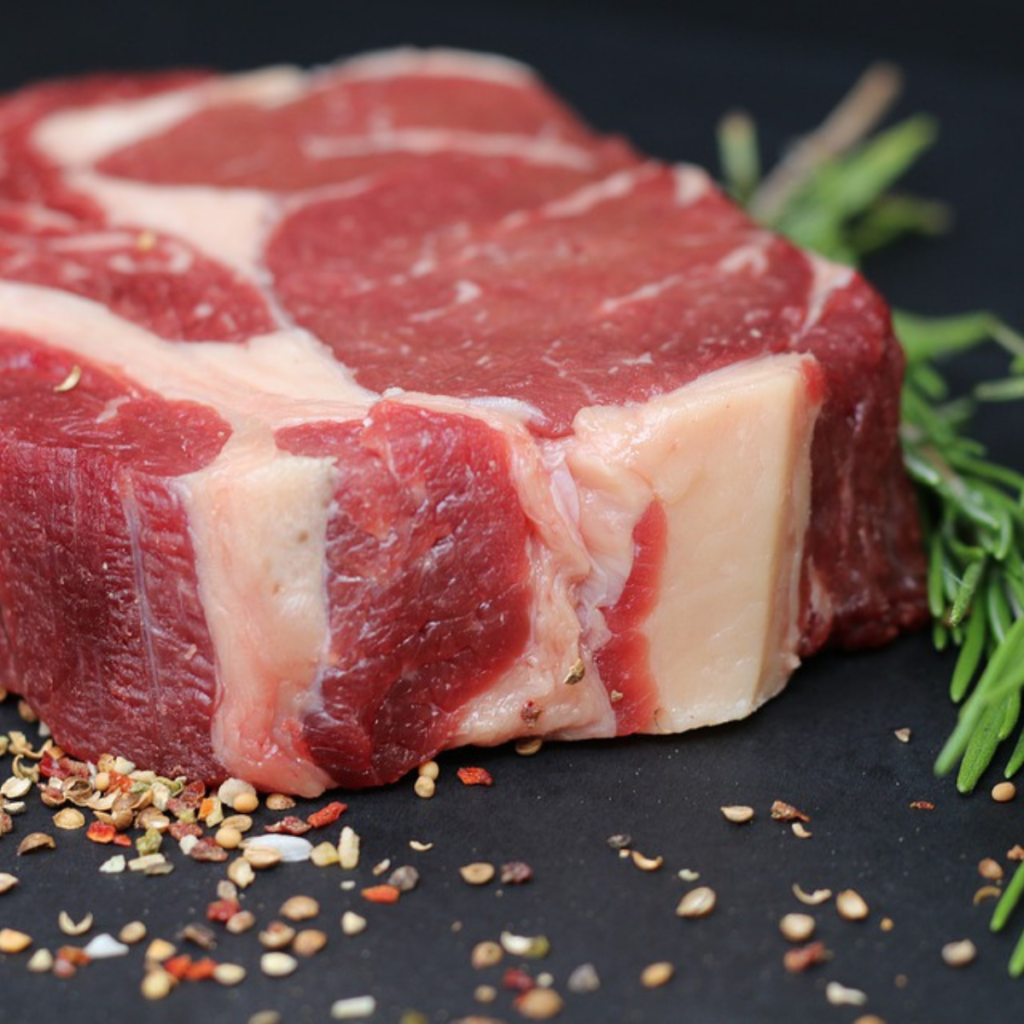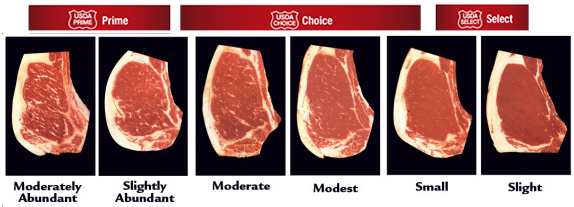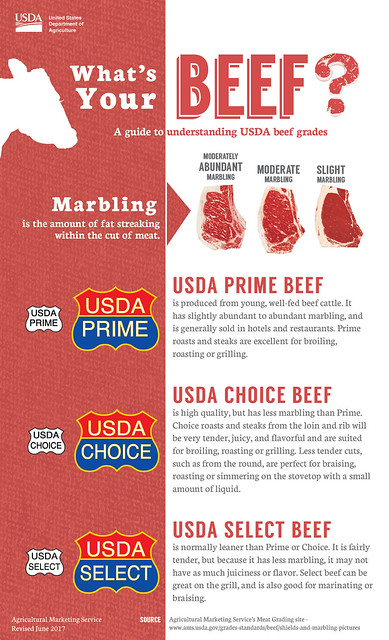Do you know the difference between Prime, Choice and Select Beef? Here’s what meat grading means (and doesn’t mean), who grades beef, and why it’s important to consumers.

When buying beef, it’s important to know the difference between the USDA beef grades — prime, choice and select. There is a huge quality, taste and price difference between these meat grades, so being aware of the differences will save you money.
Jump to:
What are grades of beef?
The USDA Grades beef to signify that it’s high-quality beef that is safe to eat. The beef grades also tell you the amount of tenderness and amount of marbling to expect in the beef.
There are eight grades of beef. The beef quality grades in order from best to worst are USDA Prime, USDA Choice, USDA Select, USDA Standard, USDA Commercial, USDA Utility, USDA Cutter and USDA Canner.
When buying beef at a steakhouse, you usually only hear about three of these USDA beef grades: Prime, Choice and Select.
Is all beef graded?
All beef in the United States is inspected, but not all beef is graded. Beef quality grading is voluntary and administered by the USDA and paid for by beef packers.

What components make up the meat grading system?
When the USDA grades beef, they look at two main qualities: 1) quality grades for tenderness, juiciness and flavor; and 2) yield grades for the amount of usable lean meat.
Of these two, quality is what consumers are most familiar with because it has to do with the tenderness, juiciness and flavor of the beef.
Quality grade: Marbling
Marbling is also known as intramuscular fat, which is the small threads of fat interspersed within beef between the muscle fibers. The fine white lines running through the steak look somewhat like a marble pattern, hence the name.
It’s important to note there’s a difference between intramuscular fat and intermuscular fat. Marbling is intramuscular fat, and is the fat inside the beef. Marbling is not intermuscular fat, which is fat on the outside that you typically trim off.
To determine a beef grade, the USDA grader looks specifically at the amount of marbling in the ribeye muscle between the 12th and 13th ribs. Based on that one location of the cow, they can then determine if the beef in the entire cow is Prime, Choice or Select. The reason this works is be marbelization is responsible for giving beef its tenderness and added flavor.
Quality grade: Maturity
Beef is also graded on the maturity (or age) of the animal. As cattle mature, their meat gets tougher and leaner. Since the tenderness of beef is directly affected by cattle’s age, the USDA considers the animal’s age as they determine the USDA Quality Grade.
After maturity and marbling are determined, the USDA combines the two factors to determine the quality grade.
Yield grade: Amount of usable meat
In addition to quality of beef, the USDA also looks at the yield grade – or the amount of usable lean meat on the carcass – when grading beef. Consumers rarely hear about this portion of the beef grading, but beef processors are very familiar with it. A yield grade ranges from 1-5 and measures the layer of fat covering the meat. For example, a yield grade of 1 would be assigned to a ribeye with 5/10 of an inch of fat covering it.
Three highest grades of beef: Prime, Choice and Select
There are eight grades of beef. The beef quality grades in order from best to worst are USDA Prime, USDA Choice, USDA Select, USDA Standard, USDA Commercial, USDA Utility, USDA Cutter and USDA Canner.
USDA Prime, Choice and Select are the three highest grades of beef.

Prime Beef comes from well-fed beef cattle and it has abundant marbling (i.e. fat within the beef). Cattle that are grain-finished will have more marbling than grass-finished beef. You usually find Prime Beef at restaurants and hotels. It’s known for being full of flavor, and very tender and juicy. Only about 2 percent of today’s beef is of the highest USDA grade, or prime, which, has the highest level of marbling.
Choice Graded Beef is very high quality, but has slightly less marbling than Prime. Choice beef is very tender and juicy. It is the most widely available grade of beef, and about 50 percent of beef is graded choice by the USDA.
Select Graded Beef is typically leaner than the higher grades. It has less marbling, and also lacks some of the juiciness and flavor of the higher graded meat. The USDA grades about 21 percent of beef with the select grade. When cooking Select beef, it’s generally best to marinate before cooking in order to get the maximum tenderness and flavor.
Standard and Commercial grades of beef are typically sold as store brand meat. The final three grades of beef – Utility, Cutter and Canner – are rarely sold at retail and are used to make ground beef and processed products.
What meat grades do not mean
The USDA does a great job grading beef, and they are always evolving and improving. However, it’s important to note that some factors that many consumers now consider important do not go into the grade. These factors include the animal’s diet (grass fed vs. grain finished), the cut, and how the animal has been raised (pasture raised or not).
Who grades beef?
All meat for public consumption in the U.S. must be inspected by the US Department of Agriculture (USDA). In some states, like Missouri, you can also have an inspector from a state inspection agency inspect meat. However, state inspected meat cannot cross state lines for sale.
Although all beef is inspected, not all beef is graded. Beef quality grading is voluntary and administered by the USDA and paid for by beef packers.
When beef is inspected, USDA inspectors first inspect the live animal to make sure they’re healthy from head to hoof and treated humanely. They also inspect things like the slaughtering process, all of the animal’s parts and organs, the temperature of the meat, and they make sure the carcass stays as clean as possible during the entire process.
If beef doesn’t pass inspection, it is removed entirely from the food supply. When beef does pass inspection, it is stamped or labeled with the USDA inspection stamp, and that means it is fit to eat.
The USDA’s inspection is all or nothing. There’s no half-way or partially-passed beef.
One More Thing!
Do you want to learn more about beef? Join our weekly e-newsletter where we share farm happenings, recipes and beef availability. Sign-up and get a cheat sheet with 9-must-ask questions before buying beef directly from a farmer. Or, we have an entire ebook about beef that goes through purchasing and preparing beef from a cattle farmers perspective.
Here are a few other links you may like:


[…] is it graded? The USDA grades beef so that you know the tenderness and amount of marbling in the beef. Prime is the highest grade, […]